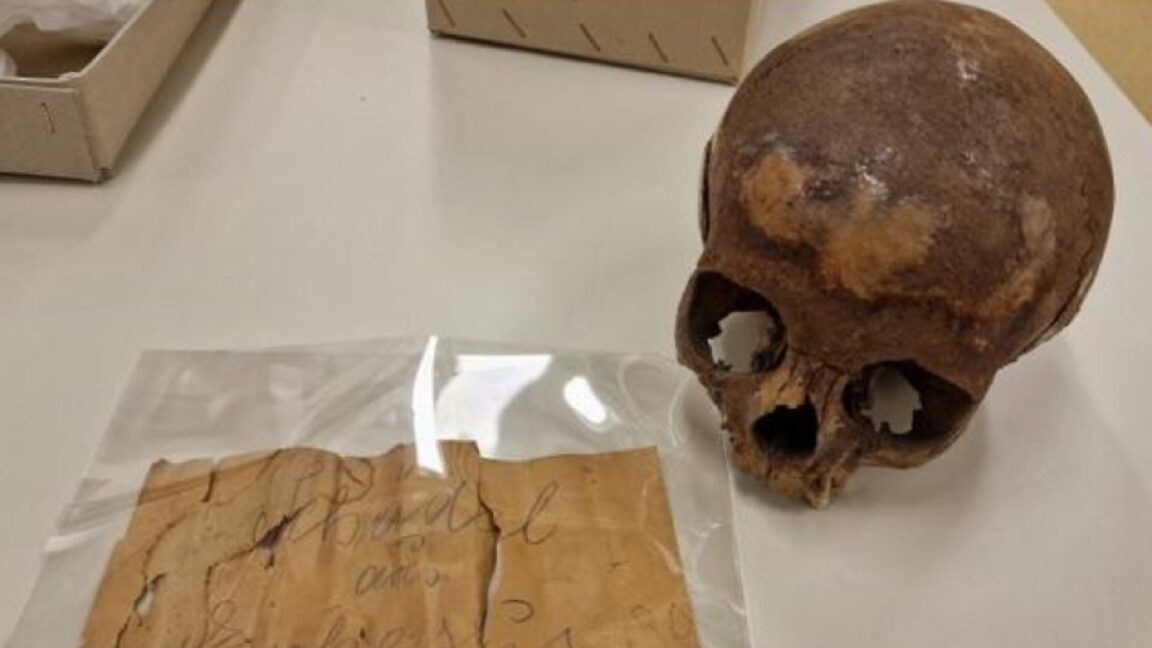
ARSTECHNICA.COM
Skull long thought to be Cleopatras sisters was actually a young boy
the search continues Skull long thought to be Cleopatras sisters was actually a young boy Skull found in ruins of Ephesos in 1929 thought to be Arsino IV is actually skull of 11-14-year-old boy. Jennifer Ouellette Jan 13, 2025 2:19 pm | 14 The cranium from the Ephesos Octagon Credit: Gerhard Weber, University of Vienna/CC BY The cranium from the Ephesos Octagon Credit: Gerhard Weber, University of Vienna/CC BY Story textSizeSmallStandardLargeWidth *StandardWideLinksStandardOrange* Subscribers only Learn moreScientists have demonstrated that an ancient human skull excavated from a tomb at Ephesos was not that of Arsino IV, half-sister to Cleopatra VII. Rather, it's the skull of a young male between the ages of 11 and 14 from Italy or Sardinia, who may have suffered from one or more developmental disorders, according to a new paper published in the journal Scientific Reports. Arsino IV's remains are thus still missing.Arsino IV led quite an adventurous short life. She was either the third or fourth daughter of Ptolemy XII, who left the throne to Cleopatra and his son, Ptolemy XIII, to rule together. Ptolemy XIII didn't care for this decision and dethroned Cleopatra in a civil waruntil Julius Caesar intervened to enforce their father's original plan of co-rulership. As for Arsino, Caesar returned Cyprus to Egyptian rule and named her and her youngest brother (Ptolemy XIV) co-rulers. This time, it was Arsino who rebelled, taking command of the Egyptian army and declaring herself queen.She was fairly successful at first in battling the Romans, conducting a siege against Alexandria and Cleopatra, until her disillusioned officers decided they'd had enough and secretly negotiated with Caesar to turn her over to him. Caesar agreed, and after a bit of public humiliation, he granted Arsino sanctuary in the temple of Artemis in Ephesus. She lived in relative peace for a few years, until Cleopatra and Mark Antony ordered her execution on the steps of the templea scandalous violation of the temple as a place of sanctuary. Historians disagree about Arsino's age when she died: Estimates range from 22 to 27. The remains of the Octagon in Ephesos Credit: Austrian Academy of Sciences/Austrian Archaeological Institute/CC BY Archaeologists have been excavating the ancient city of Ephesus for more than a century. The Octagon was uncovered in 1904, and the burial chamber was opened in 1929. That's where Joseph Keil found a skeleton in a sarcophagus filled with water, but for some reason, Keil only removed the cranium from the tomb before sealing it back up. He took the skull with him to Germany and declared it belonged to a likely female around 20 years old, although he provided no hard data to support that conclusion.It was Hilke Thur of the Austrian Academy of Sciences who first speculated that the skull may have belonged to Arsino IV, despite the lack of an inscription (or even any grave goods) on the tomb where it was found. Old notes and photographs, as well as craniometry, served as the only evidence. The skull accompanied Keil to his new position at the University of Vienna, and there was one 1953 paper reporting on craniometric measurements, but after that, the skull languished in relative obscurity. Archaeologists at the University of Graz rediscovered the skull in Vienna in 2022. The rest of the skeleton remained buried until the chamber was reopened and explored further in the 1980s and 1990s, but it was no longer in the sarcophagus.Forensic filesAnthropologist Gerhard Weber of the University of Vienna led this latest analysis of the skull, as well as a recovered femur and rib believed to be from the original skeleton. They took micro-CT scans of the skull to create an archived digital copy and took small samples from the base and inner ear for mass spectrometry and genetic testing. The Octagon cranium is scanned in the Vienna Micro-CT Lab to a resolution of 80 micrometers. Credit: Gerhard Weber, University of Vienna/CC BY The team was able to date the skull to between 36 and 205 BCE, consistent with Arsino IV's death in 41 BCE. And the genetic results confirmed that the skull and femur samples were from the same individual, although the results for the rib were inconclusive. But those results also showed a Y chromosome, meaning that the individual was male and, therefore, not the Egyptian queen. The boy's genetics are consistent with Italian or Sardinian lineage.The CT scan and morphological analysis showed that the boy was between 11 and 14 years old when he died, based on dental roots and a skull base that was still developing. There were also several distinctive abnormalities, such as a closed cranial suture that typically only fuses around age 65. This gives the skull an asymmetrical shape. The upper jaw was underdeveloped and had a downward angle that would have made it quite difficult to chew effectively. One of the two remaining teeth showed no wear at all, while the other was cracked and worn down from overuse. There were no signs of illness in the femur and rib.Weber et al. concluded that the young boy likely suffered from a vitamin D deficiency or some kind of genetic developmental disorderperhaps Treacher Collins syndromealthough "the coverage of our genetic sampling was not sufficient enough to prove genetic disorders such as TCS or others," the authors wrote. "Why this 11-14-year-old boy suffering from significant developmental disturbances was buried in such a prominent building within the Ephesos urban area also remains unexplained for the moment."Scientific Reports, 2025. DOI: 10.1038/s41598-024-83870-x (About DOIs).Jennifer OuelletteSenior WriterJennifer OuelletteSenior Writer Jennifer is a senior writer at Ars Technica with a particular focus on where science meets culture, covering everything from physics and related interdisciplinary topics to her favorite films and TV series. Jennifer lives in Baltimore with her spouse, physicist Sean M. Carroll, and their two cats, Ariel and Caliban. 14 Comments
0 Commenti
0 condivisioni


